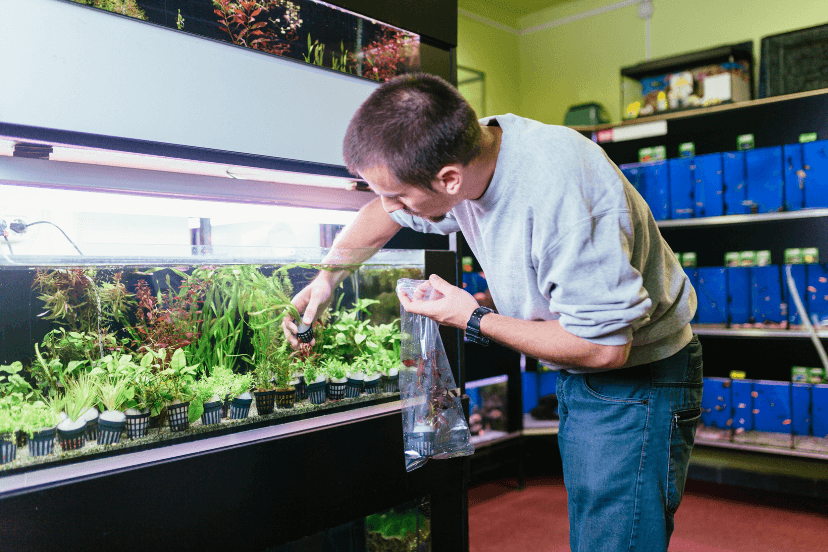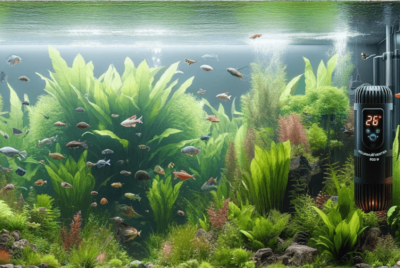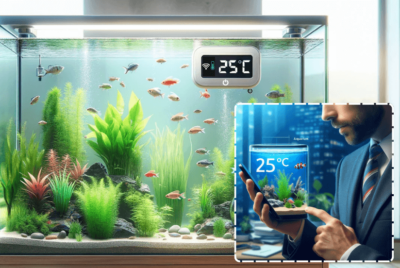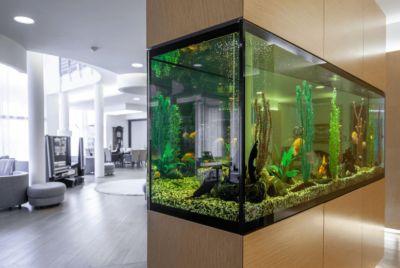Aquarium Plants: Top 7 Easy-Care Options for Busy Hobbyists
Hey there, fellow aquarists and aquarium plant enthusiasts! Are you searching for aquarium plants that suit your busy lifestyle, ones that flourish without needing constant care? Like many in our lively aquarium community, I’m passionate about creating a lush and vibrant aquarium. However, our hectic schedules often make it challenging to provide the detailed attention that some aquatic plants require. This is where the benefits of low-maintenance aquarium plants become clear. These varieties introduce a vibrant splash of greenery to your aquarium and thrive with minimal effort on your part. They are the ideal choice to enhance your aquarium’s ecosystem without necessitating frequent maintenance.
Exploring the world of easy-care aquarium plants unveils a handpicked collection. This collection is designed to transform your aquarium into an eye-catching feature without taking up too much of your time. These plants have been carefully chosen for their ability to flourish with minimal care. They perfectly meld visual appeal with ease of maintenance. This proves that a vibrant, plant-filled aquarium is achievable even for those with busy lifestyles. This demonstrates that your aquarium can indeed support a lush array of plant life, seamlessly fitting into your active schedule.
Let’s embark on a journey to discover these aquarium plant varieties. They are poised to transform your aquarium into a flourishing, easy-to-maintain aquatic paradise. By incorporating these plants, you can enjoy the harmony and beauty of a well-balanced aquatic environment with minimal intervention. This ensures your aquarium remains a serene and inviting haven.
Introduction to Low-Maintenance Aquarium Plants
Why choose low-maintenance aquarium plants for your aquatic habitat, you might wonder? Well, the advantages extend far beyond the clear time-saving perks. These aquarium plants are essential for fostering a balanced ecosystem within your aquarium. They play a pivotal role in oxygenating the aquarium’s water, significantly enhancing the habitat for your aquatic life. Furthermore, these easy-care aquarium plants offer a sanctuary and breeding grounds for your fish, underpinning the biodiversity in your tank.”
In addition to creating a more dynamic and stable environment, low-maintenance aquarium plants in your aquarium combat algae growth by efficiently utilizing available nutrients, which might otherwise fuel unwanted algae. This natural process of nutrient competition helps maintain clearer water and a healthier aquarium system. Essentially, incorporating these types of plants into your aquarium setup acts as a cornerstone for sustaining a vibrant, healthy aquarium ecosystem. They emerge as the unsung heroes, quietly contributing to the overall wellbeing of your aquatic paradise without necessitating constant upkeep.
Why Choose Low-Maintenance Aquarium Plants?
Choosing low-maintenance aquarium plants is a smart decision for hobbyists seeking to beautify their aquariums without the added burden of intensive care. These plants not only save time and effort. They also contribute significantly to the health and stability of the aquatic environment. By absorbing harmful nutrients, they improve water quality. Additionally, they provide a natural habitat for fish, promoting healthier and more vibrant aquatic life.
Additionally, their resilience to varying water conditions and minimal lighting requirements make them suitable for both beginners and experienced aquarists alike. Opting for low-maintenance plants means enjoying the aesthetic and ecological benefits of a planted aquarium. This approach allows for less time spent on upkeep and more time to appreciate the tranquil beauty of your aquatic setup.
Benefits of Low Maintenance Aquarium Plants for Aquariums
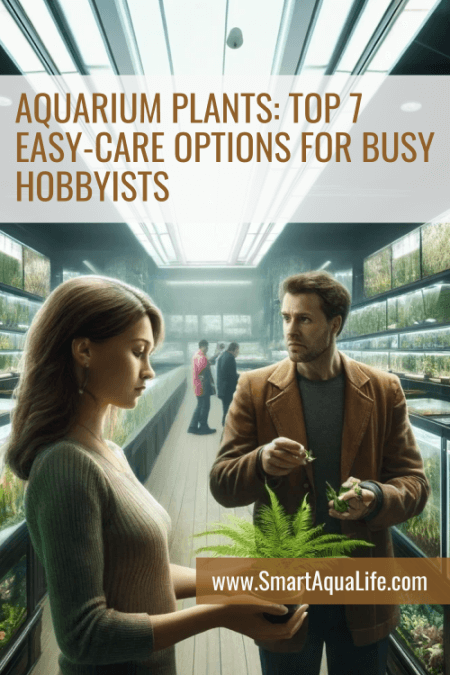
Choosing low-maintenance aquarium plants offers a multitude of benefits for both the hobbyist and the aquarium ecosystem, making them an attractive option for anyone looking to enhance their aquatic environment with less effort. Here’s why opting for these plants can be a smart move:
- Time and Effort Savings: The most apparent advantage is the reduced need for care and maintenance. Busy lifestyles can make it challenging to dedicate time to aquarium upkeep. Low-maintenance plants thrive with minimal intervention, freeing you up from frequent pruning, substrate fertilization, and specific lighting requirements. This convenience is especially appealing to beginners or those with limited time to devote to their aquariums.
- Aesthetic Appeal: These plants come in a variety of shapes, sizes, and colors, allowing for the creation of a visually appealing underwater landscape without the complexity that high-maintenance plants might demand. They can enhance the beauty of your aquarium, adding a natural and vibrant look with less effort.
- Improved Water Quality: Plants play a crucial role in the nitrogen cycle by absorbing nutrients like nitrates and phosphates. These substances can reach harmful levels in your tank if not managed. Opting for low-maintenance plants not only beautifies your aquarium. It also supports a healthier environment for your fish and other aquatic creatures.
- Stability and Resilience: These plants tend to be more forgiving of fluctuations in water parameters and lighting conditions, making them suitable for a wide range of environments. Their resilience and adaptability mean they’re less likely to succumb to stress, leading to a more stable and thriving aquatic ecosystem.
- Natural Behavior Encouragement: Plants provide shelter, breeding grounds, and hunting territories for aquarium inhabitants. Low-maintenance plants ensure that your fish have the benefits of a natural habitat without requiring the constant care that more delicate plants might need. This can lead to happier, healthier fish displaying more natural behaviors.
- Algae Reduction: By competing for nutrients and light, low-maintenance plants can help prevent the proliferation of algae in the aquarium. This not only keeps your tank cleaner but also reduces the amount of time and effort required for algae control.
- Educational Value: Starting with low-maintenance plants can be an excellent way for beginners to learn about aquatic plant care and the ecological balance of an aquarium. It provides an opportunity to understand the basics without the discouragement of high-maintenance plant failures.
In summary, low-maintenance aquarium plants offer an ideal compromise between the desire for a lush, attractive tank and the need for simplicity and ease of care. They contribute to the ecological balance of the aquarium, enhance its aesthetic appeal, and provide essential benefits to its inhabitants, all while suiting the busy lifestyle of the modern aquarium enthusiast.
The Top 7 Low-Maintenance Aquarium Plants
1. Anubias
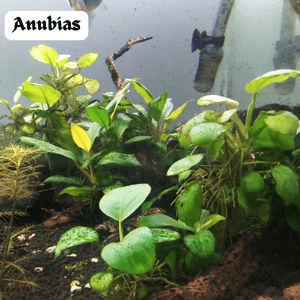
- Description: Anubias is a hardy plant with thick leaves and a short stature, known for its ability to thrive in low-light conditions. It often comes in various species, offering different sizes and leaf shapes, making it versatile for different aquarium designs.
- Care Guide: Attach Anubias to rocks or driftwood in your tank as its roots prefer not to be buried in the substrate. It requires minimal light and can do well in both CO2 and non-CO2 setups. Its slow growth rate means it requires very little pruning.
2. Java Fern

- Description: Java Fern is a leafy, green plant that features a strong rhizome and broad leaves. It’s particularly favored for its adaptability and ease of care, thriving in a variety of water parameters.
- Care Guide: Like Anubias, Java Fern should be attached to driftwood or rocks. It prefers moderate to low lighting and doesn’t need substrate or fertilizer. Java Fern is slow-growing and resists algae, making it very low maintenance.
3. Marimo Moss Balls
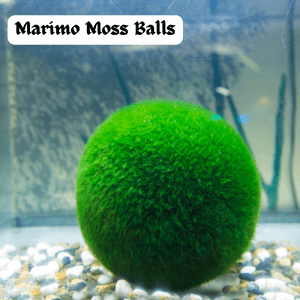
- Description: Marimo Moss Balls are not true aquarium plants but a form of algae that grows into spherical shapes. They’re incredibly resilient and can add a unique aesthetic to any aquarium.
- Care Guide: These moss balls require very little light and can be kept in cold water tanks as well as tropical setups. They benefit from being turned occasionally to maintain their shape and prevent browning. They can also be gently squeezed during water changes to remove debris.
Java Moss
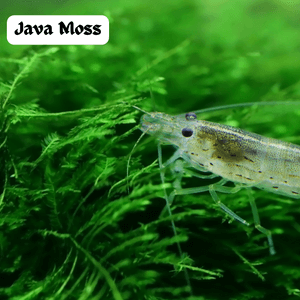
- Description: Java Moss is a versatile moss that can be used to create lush green carpets or backgrounds in an aquarium. It’s excellent for breeding tanks and provides excellent cover for fry.
- Care Guide: Java Moss thrives in a range of lighting conditions, from low to moderate. It can be attached to mesh or rocks to shape its growth. While it doesn’t require CO2 supplementation, it benefits from occasional trimming to keep it healthy and prevent it from becoming too dense.
Cryptocoryne
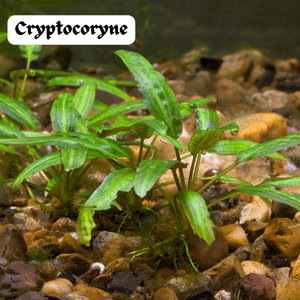
- Description: Cryptocoryne comes in various colors and sizes, offering a range of textures and hues for the aquarium. It’s known for its undemanding nature and the beautiful, sometimes wavy leaves it produces.
- Care Guide: Crypts prefer stable water conditions and can suffer from “crypt melt” if drastic changes occur. They thrive in low to moderate light and benefit from root tabs or a nutrient-rich substrate. Once established, they require very little care.
Water Wisteria
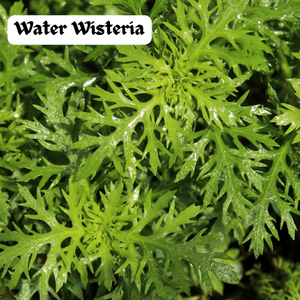
- Description: Water Wisteria is a fast-growing plant with delicate, lace-like leaves. It can be grown planted in the substrate or left to float, providing excellent cover and oxygenation for the tank.
- Care Guide: This plant prefers moderate lighting and a nutrient-rich substrate for optimal growth. It can grow quite rapidly and may require regular trimming to maintain shape and size. Water Wisteria is adaptable to a wide range of water conditions.
Amazon Sword
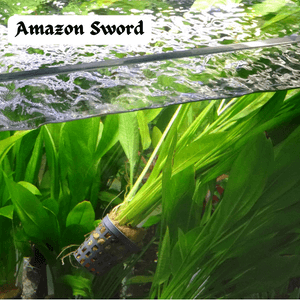
- Description: The Amazon Sword is a popular choice for background planting, with large, broad leaves that create a dense, bushy look. It’s a focal plant that can reach impressive sizes, making it a centerpiece in many aquariums.
- Care Guide: Amazon Swords benefit from a rich substrate and can be heavy feeders. They thrive in moderate to bright lighting conditions. While they can grow large, their maintenance is mostly in ensuring they have enough nutrients, either through root tabs or liquid fertilizer, and occasional pruning of old leaves.
Setting Up Your Low-Maintenance Planted Aquarium
Choosing the right substrate is crucial. While some aquarium plants are fine with gravel, others might benefit from nutrient-rich soil. Lighting should be sufficient for the plants to perform photosynthesis but doesn’t need to be high-intensity unless you’re keeping plants with higher light requirements. As for water conditions, stability is key. Regular water changes and monitoring will keep your plants and fish happy.
Choosing the Right Substrate
When setting up a low-maintenance planted aquarium, selecting the right substrate is crucial for the health and growth of your plants. A nutrient-rich substrate can provide essential minerals and support for root systems, enhancing plant vitality with minimal effort. For low-maintenance setups, consider substrates that are specifically designed for planted tanks, as these often contain the right balance of nutrients. Additionally, substrates with a larger grain size can facilitate better water flow and prevent the buildup of anaerobic pockets, which could harm your aquarium plants. Opting for a quality substrate initially can reduce the need for additional fertilization, making your aquarium care routine simpler and more straightforward.
Aquarium Plant’s Lighting Needs
Proper lighting stands as a pivotal element for the success of a low-maintenance planted aquarium, ensuring that each aquarium plant receives the illumination it needs to thrive. While plants suited for low-maintenance aquarium environments typically do well under moderate lighting, it’s critical to match the light’s intensity and spectrum to the plants’ photosynthetic requirements. The use of LED lighting, with its customizable settings for light intensity and color spectrum, offers a versatile solution. These lights can be tailored to the specific needs of various aquarium plants, streamlining maintenance without sacrificing the plants’ health.
Furthermore, creating a lighting regimen that mimics the natural cycle of daylight plays a significant role in the robust growth of aquarium plants. Implementing timers to automate lighting ensures a consistent cycle, crucial for the healthy development of your aquarium plants. This consistency not only fosters plant growth but also supports the biological rhythms of fish and other dwellers within the aquarium. By thoughtfully managing the lighting within your aquarium, you can nurture a dynamic, low-maintenance aquatic ecosystem where both aquarium plants and animals flourish.
Water Conditions for Aquarium Plants
Ensuring stable water conditions is crucial for the flourishing of aquariums, particularly those adorned with live aquarium plants. These low-maintenance aquarium plants are quite adaptable, thriving across a spectrum of water parameters, yet they show optimal growth in environments where temperature, pH, and nutrient levels are consistently managed. Regularly testing the water in your aquarium is key to monitoring these vital conditions and making adjustments as necessary. Integrating a high-quality filtration system plays a significant role in sustaining water quality, which, along with routine water changes, forms the cornerstone of effective aquarium plant care. Such practices are instrumental in eliminating excess nutrients that might otherwise promote algae proliferation, thereby maintaining a pristine tank environment and ensuring the health of your aquarium plants with minimal effort.
Furthermore, the health and vibrancy of your aquarium and its plant life hinge on this diligent attention to water quality. By adopting a schedule that includes regular checks and maintenance routines for your aquarium, you can prevent the common pitfalls that affect less diligently managed tanks. This proactive approach to aquarium and aquarium plant care not only safeguards the aesthetic appeal of your setup but also supports a dynamic, healthy ecosystem within your aquarium. Embracing these practices ensures that your aquarium remains a thriving, low-maintenance habitat for all its inhabitants, showcasing the serene beauty and complexity of underwater life with ease.
Tips for Success with Low-Maintenance Aquarium Plants
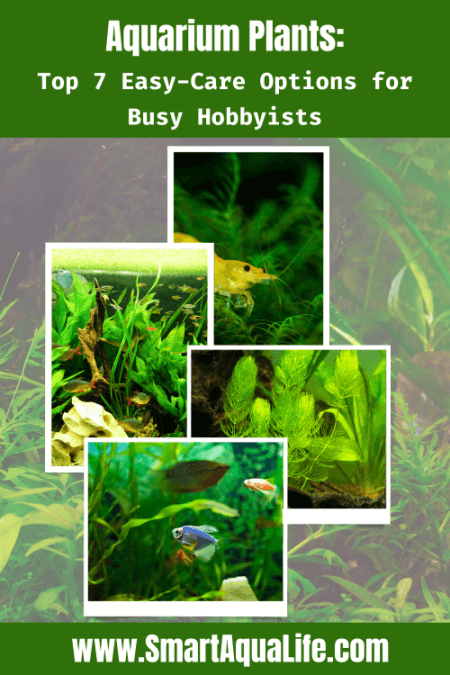
Even low-maintenance plants appreciate a little TLC. Keep an eye on your aquatic garden for signs of distress, and remove any dead leaves to prevent decay. While most of these plants don’t need frequent trimming, occasional pruning can encourage healthier growth. Fertilization depends on the plant and your tank’s specific needs, but generally, a light hand is best.
Regular Monitoring of Aquarium Plants
Even with low-maintenance plants, regular monitoring is a cornerstone of a healthy aquarium. Keeping an eye on your aquatic plants and fish can help you catch and address potential issues before they escalate. This includes observing plant growth, leaf color, and signs of stress or disease. Regular monitoring of your aquarium allows for timely adjustments to lighting, water conditions, and nutrient levels, ensuring it remains a vibrant habitat. By implementing a straightforward weekly checklist, you streamline this oversight, preventing any aspect of care from being neglected. This approach transforms your aquarium maintenance into a routine that is both efficient and easy to manage. Consequently, your aquarium care practice becomes more effective, maintaining the health and beauty of your aquatic environment with ease.
Minimal Trimming and Pruning
Minimal trimming and pruning within your aquarium play a dual role: they keep your aquatic environment aesthetically pleasing and are critical for the health of your aquarium plants and the creatures that call your tank home. When aquarium plants become overgrown, they can block essential light from reaching the lower-placed flora, inhibiting their growth and potentially affecting the oxygen balance within the tank. This situation underscores the importance of regular maintenance to ensure that every aquarium plant and animal in the aquarium can thrive.
However, the allure of selecting low-maintenance plants for your aquarium lies in their natural slow growth rate, which minimizes the need for frequent pruning. On occasions when trimming these aquarium plants becomes necessary, strategic cutting is beneficial. It not only promotes healthier growth among your aquatic plants but also preserves the visual beauty of your aquarium without demanding too much effort. This thoughtful approach to maintaining your aquarium plants ensures that your aquatic space remains both visually stunning and biologically harmonious, embodying the ideal balance sought in a low-maintenance aquarium setup.
Aquarium Plant Fertilization: Yes or No?
Deciding whether to fertilize your low-maintenance aquarium plants depends on several factors, including the type of plants, substrate, and overall tank setup. While low-maintenance aquarium plants typically require fewer nutrients than their high-maintenance counterparts, some may benefit from occasional fertilization to support healthy growth. If your substrate is nutrient-rich, additional fertilization might be unnecessary. However, if you notice signs of nutrient deficiency, such as pale leaves or stunted growth, a mild liquid fertilizer can make a big difference. Opt for specialized aquarium plant fertilizers and follow the recommended dosage to avoid over-fertilization, which can lead to algae problems. Remember, less is often more when it comes to fertilizing in a low-maintenance setup.
Integrating Smart Aquarium Technology with Aquarium Plants
In today’s digital era, smart aquarium technology is revolutionizing the way we care for aquatic plants. It’s making it easier than ever for hobbyists to maintain thriving underwater gardens. Smart devices such as automated lighting systems, pH monitors, and automatic fertilizer dispensers can precisely control the environmental conditions. This precision enables an optimal habitat for an aquarium. This ensures optimal growth conditions for a wide range of plant species. These technological advancements not only simplify routine maintenance tasks but also enhance the health and vibrancy of aquarium plants. By leveraging smart aquarium technology, enthusiasts can achieve a balanced ecosystem that supports both the aesthetic and biological needs of their aquatic plants. This eliminates the constant need for manual adjustments.
The integration of smart technology into aquarium care has revolutionized how hobbyists engage with their aquatic environments. It allows for remote monitoring and adjustments, providing a level of convenience and control previously unattainable. This shift has transformed the way aquariums are maintained, making it easier for enthusiasts to ensure the health and beauty of their underwater gardens from anywhere.
Smart devices in aquarium care allow for precise adjustments in lighting and water conditions, simplifying the maintenance of aquatic environments. This technological innovation seamlessly integrates with the inherent beauty of aquatic life. It enhances the aquarium hobby for both experienced and new aquarists. It opens up opportunities to maintain vibrant, low-maintenance aquatic ecosystems efficiently. The evolution in aquarium management marries the art of aquascaping with the advancements of modern technology. This fosters a more accessible and enriching hobby experience, marking a significant leap forward in how we care for our aquatic friends.
Conclusion
Incorporating low-maintenance aquarium plants into your aquarium is a savvy strategy for creating a beautiful, self-sufficient aquatic environment. This approach allows for a vibrant underwater scene without requiring constant oversight. Whether you’re an experienced aquarist or a newcomer to the realm of fishkeeping. Opting for these easy-care plants can seamlessly blend hassle-free maintenance with visual appeal. They introduce a piece of nature’s calm into your living space. This positively impacts the lives of your underwater companions and eases your care routine. This method not only beautifies your aquarium. It also simplifies the management of your aquatic habitat. Making it an ideal choice for enthusiasts at any level. By choosing low-maintenance plants, you ensure your aquarium remains a tranquil, attractive feature in your home. This reflects the serenity and beauty of the natural world.
So, why not embrace the beauty and simplicity these aquarium plants offer? Dive into the world of low-maintenance aquarium plants, and watch as they transform your tank into a thriving, hassle-free ecosystem. Trust me, your fish—and your busy schedule—will be all the better for it.
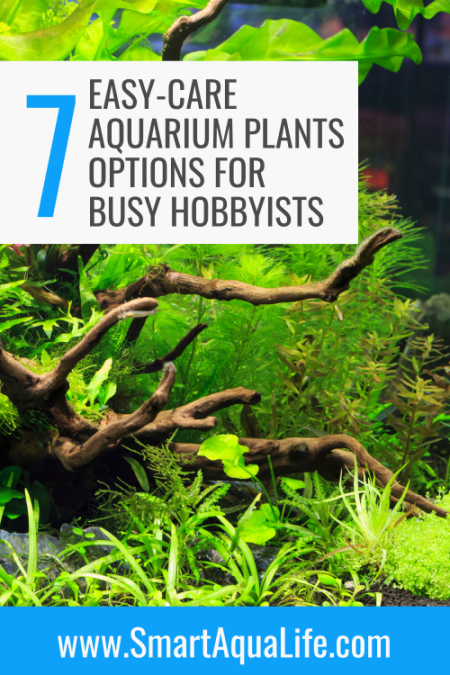
Aquarium Plants FAQs
Q: Can these plants survive in any water conditions?
A: While they’re forgiving, extreme conditions can stress them. It’s best to aim for a stable environment.
Q: How often should I trim these plants?
A: It varies by species, but generally, minimal trimming is needed. Just keep an eye on growth and prune as necessary.
Q: Do I need a CO2 system for these plants?
A: No, these plants typically do well without additional CO2, making them ideal for low-tech setups.
Q: Can low-maintenance aquarium plants thrive in low-light conditions?
A: Yes, most of the plants listed are well-suited to low-light environments, making them great for beginner tanks.
Q: What are the signs of unhealthy aquarium plants?
A: Look out for discolored leaves, slow growth, or shedding. These can indicate poor water quality or incorrect lighting.

